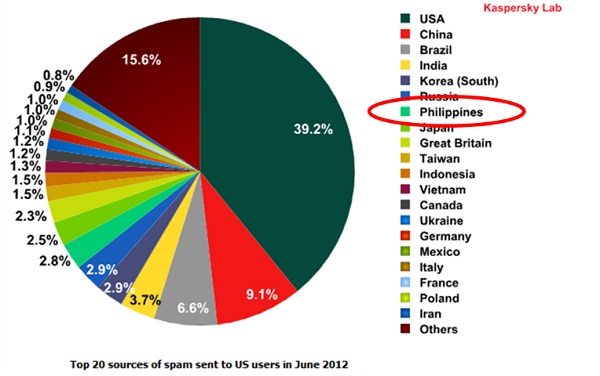PH among top spammers to US and Europe, says report
MANILA, Philippines – The Philippines is one of the top sources of spam that hit the US and Europe recently, according to a technology firm specializing in content development and threat management solutions.
In its June spam report, Kaspersky Lab said the Philippines ranked 7th out of 20 countries with a share of 2.8% in spam distributed to the US. Incidentally, the US is the main source of distributed spam, ranking 1st with a share of 39.2%. It is followed by China with 9.1%, Brazil with 6.6% and India with 3.7%.
According to Kaspersky Lab’s official blog Securelist.com, spam is the name commonly given to unsolicited e-mail. It is effectively an unwanted advertising, an e-mail equivalent of physical junk mail delivered through the post or from unsolicited telemarketing calls.
Maria Namestnikova, Senior Spam Analyst of Kaspersky Lab, said that there was a slow downward trend in spam in mail, which could be partially attributed to a seasonal “summer” fluctuation wherein spam bot computers were being turned off by their owners for the holiday.
In the same report, the Philippines was tagged as one of the contributors of spam that resulted in an unexpected surge of spam percentage in the category of personal finance which almost tripled in size with 73.9% then followed by medications, health-related groups and services with 10.6%, computer fraud (9.6%), adult content spam (3.5%), gambling (1.3%) and other categories which accumulated 1.0% of the total spam in June.
The target for spammers in the US is the July 4th Independence Day celebration. As is the case with any other major holiday in the western hemisphere, it is accompanied by a wave of spam offering fake designer watches and various other accessories as gift ideas. There were also mass mailings advertising flags to help Americans express their patriotic feelings.
“We would like to draw your attention to the fact that during the summer holidays spammers tend to focus on children and students and the services they use – social networking sites and online stores. Teenagers should be aware of the risks that lie in wait for them on the Internet. At the very least, parents need to make sure their children have enough knowledge about IT security so they don’t pass on credit card data to cybercriminals while shopping online,” Namestnikova added.
Meanwhile, the Philippines ranked 19 among the top 20 countries that are sources of spam to Europe. However, the Philippines’ share is just 0.8% of the total, a small percentage compared to China’s share of 36.6%, followed by India with 12.6% and U.S. with 4.9%.
The main target for spammers in Europe was the European Football Championship 2012, the biggest sporting event in the region that lasted the whole month of June. Various spam offerings were sent out related to Euro 2012, from travel offers, Nigerian letter-styled lottery, and online streaming of the games.
On the other hand, the amount of spam in emails decreased to 1.9 percentage points compared to May and averaged 71.9%. Malicious files were also found in 3% of all emails, which is an increase of 0.2 percentage points compared with the month of May.
Trojan-Spy.HTML.Fraud.gen led the most number of malware attached to email accounting for more than 10% of all detections. It is followed by Packed.Win32.Katusha.o. In addition, mail worms still dominate malwares in terms of detection, which is not surprising considering their uncontrolled mechanism of self-distribution.
Three newcomers to the Top 10 malicious programs spreading via email in June belong to the Trojan.Win32.Androm family such as Trojan.Win32.Androm.py occupied the 4th place, Trojan.Win32.Androm.ow ranked as the 5th and Trojan.Win32.Androm.ni on the 8th place. Once these malicious programs are installed on a computer, they start downloading other malware from the Internet.
The proportion of phishing emails remained unchanged from May’s figure, accounting for 0.01% of all mail traffic. Social networking sites have again become the primary target with 25.2% share of all targets and Facebook is still their prime target.
